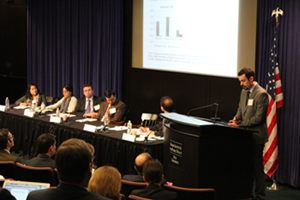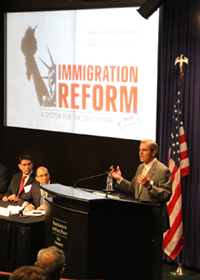Immigration Reform Must Offer Citizenship over Perpetual Guests: The Baker Institute
 On April 4, 2013, The Baker Institute hosted a Conference: Immigration Reform: A system for the 21st Century. It was a forum where U.S. immigration experts, key public policy and political figures discussed the specifics of how to revamp our current broken immigration system. Discussed were specific issues that included “the changing demographics of the nation, the state of the economy and the American labor force, border security, the presence of millions of undocumented immigrants throughout the country, and the political obstacles to be overcome in the finer details of the future law.”
On April 4, 2013, The Baker Institute hosted a Conference: Immigration Reform: A system for the 21st Century. It was a forum where U.S. immigration experts, key public policy and political figures discussed the specifics of how to revamp our current broken immigration system. Discussed were specific issues that included “the changing demographics of the nation, the state of the economy and the American labor force, border security, the presence of millions of undocumented immigrants throughout the country, and the political obstacles to be overcome in the finer details of the future law.”
The discussion started with the changing demographics in the U.S. and how they affected the future of the political parties in the U.S., and new citizens, with new freedoms and rights.
America began its population growth with the Naturalization Act of 1790. We needed open borders because of the sparse population. But we started restricting those who could enter the U.S. by imposing taxes and making many inadmissible because of marital status, profession, or mental disabilities.
Texas and the Southern neighbor, Mexico, always had an understanding and had co-existed without much difficulties. While many were entering the U.S. through Ellis Island up north, in the Southwest, we had people coming and traveling to and exiting the U.S. without problems.
However, as time went on, we started to have changes in our immigration policies and quotas. These began because we wanted to limit those who would come from Europe, mainly Italians, Eastern Europeans who were mainly Jewish, the Irish and Asians. In fact, the Chinese Exclusion Act of 1882 prohibited Chinese laborers from coming to the U.S.
In 1907, the reorganization of the Border States began restricting those entering the U.S. along the borders. For the first time, people were asked their nationality when entering through the southern border. Between 1917-1924, quotas were heavily applied to restrict those groups named above. The term “excludable” became used in immigration law to allow us to refuse entry to those who didn’t meet our standards, under the law. It went beyond not allowing entry for committing a crime, and in fact dealt more from the country of origination. The idea was that those from certain countries were not “bred” for the good quality stock of citizens that we were trying to control in building the Utopia of America.
And even after the passage of the 1924 Immigration Law, we had lenient laws for Mexican immigrants who came to work in agriculture across the southwest.
During that time, Mexicans came into America to work for the agriculture industry. The influx created a new threat to the “Americanization” that many wanted to implement in the U.S. Subsequently, the Depression brought upon the U.S. a deep resentment for Immigrants along the Southwest at which time Mexicans were repatriated back to Mexico, and again in the 1950s after the soldiers came back from Europe and the Pacific. Many U.S. Citizens (of Mexican descent) were forcibly made to leave their U.S. home. WWII also brought a camp created especially for Japanese-Americans, and about one thousand Italian-Americans who sympathized with Mussolini, were sequestered for National Security protection.
This current proposal before the U.S. Senate, regarding comprehensive immigration reform, is about numbers; economic numbers necessary to stabilize our economy and promote growth, yet many want to create a social division on ethnicity. We shouldn’t.
 Businesses always seem to absorb the blow of Immigration Reform. However, as Stan Marek, of Marek Brothers Industries made note during the presentation at the Baker Institute, it also creates a pathway to dishonesty. The competition becomes so regulated and mismanaged by the federal government, that loopholes allow individuals to create their own “independent contractor” system whereby they avert paying taxes and don't have a safe environment for workers. What happens additionally is that workers in the unskilled industry have to wait in the web of quotas.
Businesses always seem to absorb the blow of Immigration Reform. However, as Stan Marek, of Marek Brothers Industries made note during the presentation at the Baker Institute, it also creates a pathway to dishonesty. The competition becomes so regulated and mismanaged by the federal government, that loopholes allow individuals to create their own “independent contractor” system whereby they avert paying taxes and don't have a safe environment for workers. What happens additionally is that workers in the unskilled industry have to wait in the web of quotas.
Any Immigration proposal must apply a fairness for quotas not only for the specialized worker, but for the industries that demand workers in construction and services that require minimal skill. Today we have Mexican immigrants who still, like in the 1920, come to work in agriculture, and other lows-skilled industries, because we don’t have enough “able bodies” willing to perform those jobs, even if we have high unemployment. So this is about real numbers for our economy that affects real jobs and real people. I am not suggesting that we should have lenient laws like we did in 1920s for Mexican-immigrants who want to come to work in agriculture. What I am suggesting is that we must have immigration laws for our economy that are based on real numbers and the market necessity.
The Citizenship path is essential if America is to survive, otherwise we will be inundated with “guests” who will neither care to give an allegiance to this country nor will they care for our Constitution as our Supreme Law of the Land. Eventually, populations stifle and ours is slowing, but not for the Latino portion. Latinos are increasing in their share of the population, not because they have more babies at higher rates than other groups, but rather because about 70% of Latinos are in their prime childbearing years while average “whites” are in their mid-forties. As a result, the changing demographics in our nation is a natural progression of any nation. So we must make the effort to create success in America, not by the color of skin or language spoken, but by creating “New Citizens” who will have the allegiance to our America and her form of government—the Constitution.




Comments
Join the Discussion on Facebook
Join the discussion on Facebook.